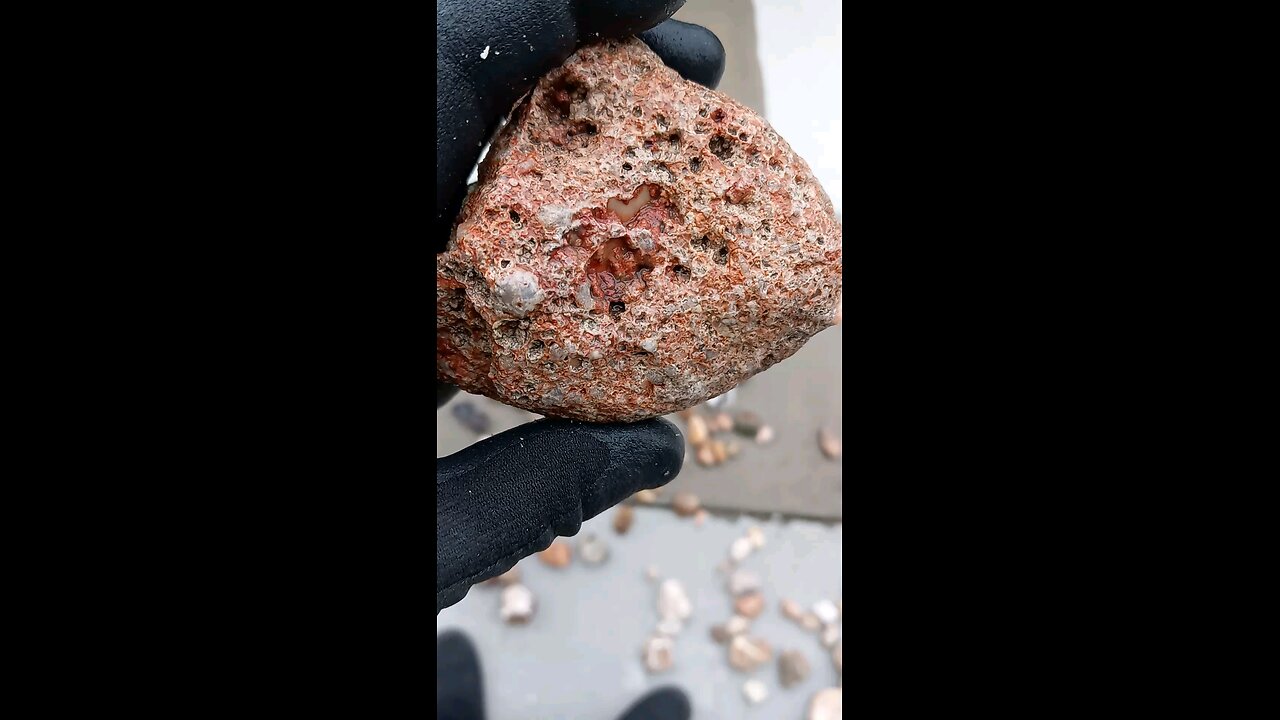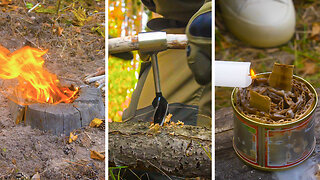Premium Only Content

Big Red!
This rock appears to be a type of igneous rock known as vesicular basalt. Here's why:
Texture and Appearance: The rock has a porous, hole-filled (vesicular) texture, which is characteristic of basalt that has cooled quickly from lava, trapping gas bubbles as it solidifies. These holes or vesicles are where gas escaped or was trapped during the rapid cooling process.
Color: The reddish-brown color suggests the presence of iron oxides, which can give basalt this hue, especially if it has been weathered or oxidized.
Formation: Basalt is an extrusive igneous rock, meaning it forms from lava that erupted onto the Earth's surface. The rapid cooling of lava at the surface causes the formation of small crystals, and if the lava contains gas, it can form vesicles as seen in the rock.
This type of rock is common in volcanic regions and can be found in lava fields or near volcanic vents. If you're interested in a more precise identification or if you want to explore its mineral content, consulting with a geologist or using advanced analytical techniques like X-ray diffraction would be beneficial.This rock appears to be a type of igneous rock known as vesicular
basalt. Here's why:
Texture and Appearance: The rock has a porous, hole-filled (vesicular)
texture, which is characteristic of basalt that has cooled quickly from
lava, trapping gas bubbles as it solidifies. These holes or vesicles are
where gas escaped or was trapped during the rapid cooling process.
Color: The reddish-brown color suggests the presence of iron oxides,
which can give basalt this hue, especially if it has been weathered or
oxidized.
Formation: Basalt is an extrusive igneous rock, meaning it forms from
lava that erupted onto the Earth's surface. The rapid cooling of lava at
the surface causes the formation of small crystals, and if the lava
contains gas, it can form vesicles as seen in the rock.
This type of rock is common in volcanic regions and can be found in lava
fields or near volcanic vents.
-
![CIA EXECUTES LARGEST MASS FIRING IN 50 YEARS - HEGSETH FIRES WOKE GENERAL [EP 4448-8AM]](https://1a-1791.com/video/fwe2/78/s8/1/e/3/n/9/e3n9x.0kob-small-CIA-EXECUTES-LARGEST-MASS-F.jpg) LIVE
LIVE
The Pete Santilli Show
16 hours agoCIA EXECUTES LARGEST MASS FIRING IN 50 YEARS - HEGSETH FIRES WOKE GENERAL [EP 4448-8AM]
1,558 watching -
 LIVE
LIVE
Jeff Ahern
1 hour agoFriday Freak out with Jeff Ahern (Chainsawing DEI)
356 watching -
 46:31
46:31
PMG
12 hours agoHannah Faulkner and Mary Flynn | REVIVING THE AMERICAN DREAM - GROWING UP A FLYNN
2.35K1 -
 3:01
3:01
Kirill MultitoolOfficial
1 day ago $5.36 earnedSurvival skills and Bushcraft HACKS in the forest!
30.6K5 -
 11:52
11:52
Dr. Nick Zyrowski
12 hours agoWhat Can I Eat On The Carnivore Diet? | Detailed Guide
30K8 -
 16:23
16:23
TSPLY
20 hours agoNew CNN / MSNBC Meltdown Moments Of Getting Mad At Donald Trump And Elon Musk
21K19 -
 30:54
30:54
Cooking with Gruel
19 hours agoCooking with Matt and Ginger Gaetz
21.2K5 -
 1:22:55
1:22:55
MTNTOUGH Fitness Lab
22 hours agoHomeland Security Pulls Us Off The Plane! Jaw-Dropping Moments from MTNTOUGH's 2024 Ibex Hunt
47.3K2 -
 1:05:30
1:05:30
Kyle Rittenhouse Presents: Tactically Inappropriate
16 hours ago $1.06 earnedHey Doge, Where's My Coin?
22.8K3 -
 4:44
4:44
America First Policy Institute
23 hours agoAmerica First Unfiltered: Trump’s Historic First Month – Real Wins for Real Americans! 🇺🇸 #news
26.2K2